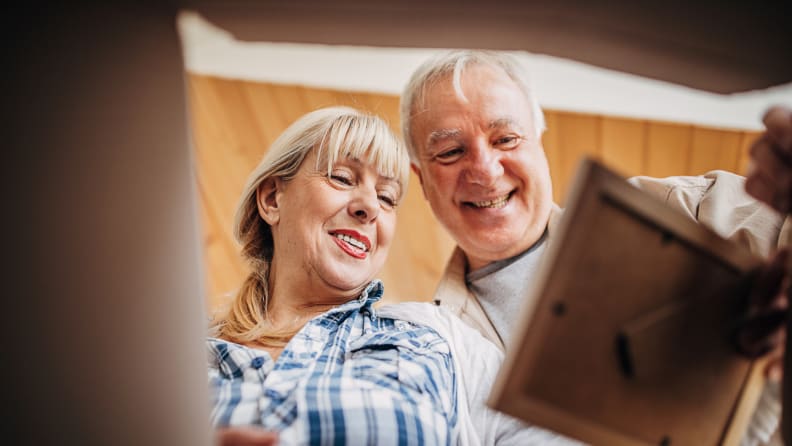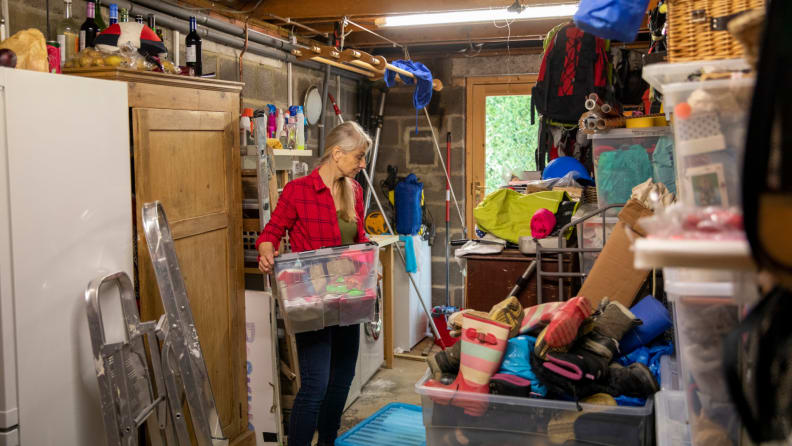 — Recommendations are independently chosen by Reviewed’s editors. Purchases you make through our links may earn us a commission.
— Recommendations are independently chosen by Reviewed’s editors. Purchases you make through our links may earn us a commission.Just because seniors encounter mobility issues as they age doesn’t mean they necessarily need to move to a different home or assisted living facility, say experts. With some organizational tips, tools, and space rearranging, accessible downsizing is possible.
Deborah Gussoff, a Certified Professional Organizer and owner of In Order, Inc., says a large portion of her business is working with baby boomers and seniors who think they have to downsize—typically by paring down their possessions in order to move to a smaller space. But what she calls “rightsizing” might be the best approach. “You can modify the volume of stuff you own to age in place in a safer, easier-to-manage way,” Gussoff advises.
1. Consider first-floor living

Trip or fall hazards are more likely to occur with steep or lengthy staircases.
“One of the easiest things to do if you’re living in a two-story home is to move all essential activities to the main floor,” says Candi Ruppert, another CPO and owner of Sage Organizing. “Those upstairs bedrooms and bathrooms can be used for more storage. I even have clients that turn the heat off or way down up there.” By converting to first-floor living that way, seniors can often save on utilities, Ruppert says.
“Repurpose traditional spaces, like making a dining room into a bedroom or office,” Ruppert continues. “It’s often easier to move things around in the home you’re already in, as opposed to moving out of it.”
2. Call in a professional

Want to minimize your clutter but don't know where to start? Consider a specialist to help.
Anne Lucas, a senior move specialist with Ducks in a Row Organizers in Massachusetts, is also a proponent of one-floor living—the only caveat being that many homes in her area lack bathrooms with showers or tubs on those floors.
She suggests nailing down a Certified Aging in Place (CAPS) contractor as soon as the senior considers staying in their current home or downsizing. One of those professionals can perform an inspection to advise on updates so a senior can budget not only their resources but time. “Physically and emotionally, downsizing and decluttering take longer than you think,” adds Gussoff—sometimes six months or more, she says.
3. Make room to move

Not only can rearranging your furniture improve your safety at home, but it can remix your décor for the better.
One of Ruppert’s initial considerations is clearance for any mobility aids like a walker or rollator a senior needs (or may need in the future). While areas like the living room may be easier to tackle by rearranging or altering furniture, for example, the bathroom’s smaller fixed spaces—and myriad trip hazards—are typically a challenge.
“You need to make sure that the footprint of the bathroom is bigger for mobility devices, and completely accessible—the hand rails, the higher-profile toilet, those need to be the top priority,” Ruppert says.
Installing even thresholds between rooms is another update that tops the CAPS checklist to prevent falls, Ruppert continues. But ultimately, all three experts agree with Gussoff: “Less clutter not only means open, safer walkways and paths, but it also reduces how much you need to clean, maintain, insure, and otherwise take care of.”
4. Declutter, then organize

While it may be a hard process to part with sentimental items, a tidy space will be the biggest reward.
Physical space is a scientific equation that can often be easier to solve than the emotional complexities behind saving sentimental clutter, says Ruppert. She advises “chipping away at the block” with the items that will have the fewest memories attached to them—like that “no man’s land underneath the kitchen sink” with cleaners that haven’t been used in ages.
“Then moving on to the coffee mugs—each of which seems to have a story behind it—gets a little easier and you feel a sense of accomplishment,” she says. That extra space that’s cleared up in a cabinet creates extra storage space for other essential items, which also saves money on securing additional storage space or moving.
5. Get creative with storage

Be careful of overstuffing large bins as they have to be handled and stored away.
There’s an art and a science to organizing and storing what remains from downsizing, say the organizers.
They agree that seniors with limited mobility or arthritis will need containers that are easy to open and close, and they suggest storage bins or containers with lips and handles. Heavy items also need to be stored at the bottom of closets, for example, since lifting overhead can strain the back.
Gussoff is a fan of investing in shelving systems, particularly in the kitchen, and recommends Shelf Genie’s pull-out options. And, “vertical desktop file boxes to corral papers are always more accessible than horizontal piles,” she says.
Lucas suggests thinking outside the box when selecting new furnishings or storage units. She cites a recent client who wanted to store her towels in the bathroom, but traditional cabinets labeled for powder rooms didn’t suit her space. Lucas was able to find a wine rack and the elderly woman was able to roll her towels to fit into spots for the bottles.
Related content
-

Yogibo Bean Bag Chair Reviewreview
-

Reviewed's coverage of autism products and topicseditorial-series
The product experts at Reviewed have all your shopping needs covered. Follow Reviewed on Facebook, Twitter, Instagram, TikTok or Flipboard for the latest deals, product reviews, and more.
Prices were accurate at the time this article was published but may change over time.


